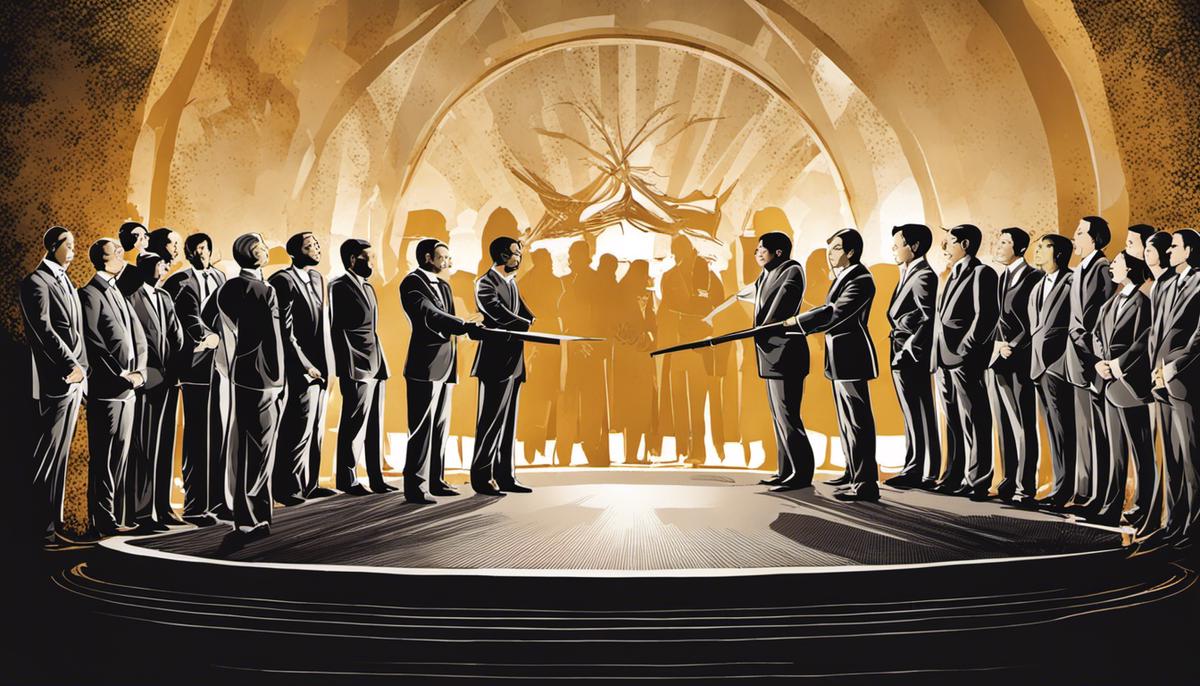Leadership is a remarkable characteristic, instrumental in guiding a team towards achieving its objectives. A skilled leader is able to blend strategic oversight, interpersonal skills, clear communication, and decision-making acumen, under an umbrella of individual personal style. In essence, this tapestry of diverse attributes forms the crux of a successful leader who commands respect and is capable of inspiring their team. This essay delves into the nuanced aspects of leadership – from understanding the essentials of being a leader and identifying personal leadership style, to fostering effective communication, enhancing decision-making capabilities, motivating and mentoring the team, and dealing with challenges and conflict resolution.
Understanding the essentials of leadership
Understanding the Essentials of Leadership
Leadership is a crucial dynamic in every team, whether in a business, sports, or any group-oriented setting. There are different types of leadership styles with unique attributes and impact. They include autocratic leadership, democratic leadership, laissez-faire leadership, transactional leadership, transformational leadership, and servant leadership.
Significance of Leadership in a Team
The role of leadership in a team is vital. They serve as the driving force that steers the group towards its goals. They influence and inspire team members to contribute their best, fostering a sense of unity, harmony, trust, and cooperation. A strong leader cultivates a positive team dynamic, enhancing morale, motivation, engagement, and productivity.
Leaders also play a significant role in problem-solving and decision-making. They hold the capacity to maintain perspective, think critically, strategize efficiently, and make sound decisions. This makes them pivotal in navigating the team through challenges to reach their targets.
Additionally, Leaders often act as the communication hub within a team, ensuring that everyone is updated, receptive to feedback, and aware of their roles and expectations. They harness effective communication skills to build rapport, resolve conflicts, and promote transparency and mutual understanding within the team.
Integral Roles of a Leader
Positioned at the helm of a team, a leader typically shoulders an array of responsibilities that can shift according to the situation and the chosen leadership style. Foremost, leaders define and broadcast the team’s vision, objectives, and strategy, ensuring the team maintains a sharp focus on the bigger picture. Oftentimes, they are also saddled with the task of making pivotal decisions that can significantly influence the team’s path.
Not only do leaders lay out the vision and direction, but they also work to establish an environment that breeds team spirit and mutual respect. To foster this positive ambiance, they strive to cultivate a culture that celebrates diversity, facilitates open dialogue, commends effort, pardons errors, and nurtures career development.
Furthermore, leaders bear the responsibility for the performance growth of their team. They work towards recognizing and leveraging the unique skills of each team member, steering their career development, offering constructive criticism, inspiring them, and managing any performance-related issues.
In conclusion, leaders are often the face of the team when interacting with external stakeholders. They represent their team’s interests and negotiate resources or agreements, while tactfully addressing any arising conflicts and managing external expectations in congruity with the team’s potential and objectives. Ensuring their team has all the necessary tools and support to succeed is also a key part of a leader’s role.

Identifying personal leadership style
Comprehending Different Leadership Styles
The concept of leadership styles encompasses the range of behaviors, attitudes, and strategies employed by a leader when steering a team or an entire organization. Distinct styles of leadership can be observed, often shaped by factors such as the leader’s individual personality, the specific industry, and the overarching culture and goals of the company. Gaining clarity on your unique leadership style can prove instrumental in enhancing your proficiency as a leader, guiding your team effectively towards their objectives.
Characteristics of Leadership Styles
Autocratic leaders tend to make decisions without consulting their teams. This style is considered highly efficient in periods of crisis but could be viewed negatively by the team due to lack of direct involvement in critical decisions.
Democratic leaders make decisions based on the input of each team member. This style fosters creativity and team engagement, though it might lead to slower decision-making as various perspectives are considered.
Laissez-faire leaders allow their teams to make decisions independently. It encourages self-reliance within the team and might be useful with mature teams. However, it may lead to lack of direction if not managed properly.
Transactional leaders focus on reward and punishment system. This leadership style works best for teams with quantifiable tasks but may struggle with problems that need out-of-the-box solutions.
Transformational leaders work by inspiring their team towards a common goal. They are often seen as charismatic and engaging. This leadership style is best suited for organizations that prioritize constant change and innovation.
Identifying Your Personal Leadership Style
There are a variety of assessments and methods that can help in identifying one’s leadership style.
Self-assessment questionnaires and personality tests, for example, can provide insight into an individual’s leadership behavior. These assessments often involve scenarios and require the individual to respond according to how they would react.
360-degree feedback is another popular method. It involves feedback from team members, peers, and superiors, and can give a well-rounded view of an individual’s leadership style.
Additionally, coaching or mentoring by a seasoned leader can also help an individual to recognize their inherent leadership style.
Importance of Understanding Your Leadership Style
Understanding your personal leadership style is pivotal in managing a team effectively. Leaders with a clear understanding of their leadership style are more likely to leverage their strengths, work on their weaknesses and adapt to different situations. They are better equipped to motivate their teams, improve productivity and foster a better work environment.
Moreover, having this knowledge aligns leadership behavior with an organization’s values and goals, promoting a cohesive and efficient operational culture. Therefore, understanding one’s personal leadership style helps not just the leader but positively impacts the entire team and prospects of the organization.
In conclusion, identifying and refining your personal leadership style is a critical aspect of professional development. It not only enhances individual leadership skills, but also contributes to the team and the organization’s overall success.
Leadership: An Ever-Evolving Journey
Effective leadership is not a fixed concept but a dynamic process. Exceptional leaders recognize the importance of flexibility and adaptability in their leadership style. They adjust their approach based on different circumstances, tasks, or individuals they engage with. Emphasizing the continuous evolution of leadership is crucial in creating thriving, successful leaders.

Developing communication skills
The Crucial Role of Communication in Effective Leadership
One of the pivotal capacities of a leader lies in effective communication. Clear and precise delivery of information, expectations, and feedback can significantly enhance a team’s productivity, boost morale, and contribute to its overall success. Communication is not just about verbal exchanges but also includes non-verbal cues like facial expressions, body language, and tone of voice. These often reveal more about intent or sentiment than words alone.
Upstanding leaders understand the interplay between verbal and non-verbal communication and its effects on team dynamics and outcomes. They skillfully leverage these forms of communication to foster trust, inspire and motivate team members, provide clear directions, and cultivate a constructive team environment.
Active Listening and Empathy: Vital Components of Communication
An essential component of effective communication in leadership is active listening. Active listening is the practice of fully focusing, understanding, responding, and then remembering what is being said. This encourages open dialogue and engenders mutual respect among team members. Leaders who demonstrate active listening validate their team members’ perspectives, promoting a collaborative and inclusive atmosphere.
Similarly, empathy is another key aspect of effective leadership communication. It is the ability to understand and share the feelings of another person. Empathetic leaders validate their team members’ feelings and perspectives, even if they do not align with their own. This emotional intelligence nurtures an environment of trust, understanding, and mutual respect.
The Role of Constructive Feedback in Leadership Communication
Another noteworthy aspect of effective communication in leadership is the ability to provide constructive feedback. Providing accurate, helpful feedback is crucial to a team’s performance, growth, and overall success. Effective leaders give feedback that is specific, timely, and actionable—focusing on behaviors and outcomes rather than personal characteristics.
Constructive feedback, when delivered correctly, is a powerful tool that fosters professional growth and a learning culture in the team. It empowers team members, making them rapidly adapt, grow, and perform at their highest potential, while also fostering a culture of continuous improvement and excellence.
Demonstrating good communication within teams
An example of good communication within a team can be a leader who can simplify complex issues, explains them clearly to the team, actively listens to their inputs and concerns, responds empathetically, and provides constructive feedback. Such leaders inspire trust. They foster an open, inclusive atmosphere where everyone feels valued and heard, which ultimately enhances team productivity and fulfillment.
For example, a project leader navigating a software development project with an unsuspecting issue. The leader must not only explain the issue to the team but also actively listen to their proposed solutions and provide feedback. By using effective verbal and non-verbal communication, the leader can facilitate a discussions, encourage problem-solving, and reassure the team. Through empathy, the leader can understand any concerns or frustrations and flexibly adapt their strategies. By giving constructive feedback, the leader can guide the team towards the project’s successful completion.
Mastering effective communication strategies such as verbal and non-verbal communication, active listening, empathy, and constructive feedback constitute the bedrock of successful leadership within any team framework. Exceptional leaders not only implement these skills, they also foster an environment where these communication practices are encouraged and nurtured.

Enhancing decision-making capabilities
Refining Decision-making Competencies in Leadership
An integral facet of remarkable leadership lies in the capacity to make informed and effective decisions. Such decisions invariably determine the direction and achievement of the team, business, or wider organization. Therefore, refining decision-making competencies should be a fundamental focus in leadership skill development.
Decision-Making Models
Different models of decision-making can help leaders approach various situations systematically and effectively. Here are a few important models that can serve as guides:
- The Rational Model: This concept is ideal for making calculated decisions. Leaders define the problem, identify the decision criteria, weigh these criteria, list down possible alternatives, evaluate these alternatives, and then finally select the best one.
- The Intuitive Model: This model focuses on using intuition or gut feeling when deciding. It’s often used when there’s no clear-cut right or wrong decision.
- The Collaborative Model: Here, leaders involve their team members in the decision-making process. The decision is made after collecting input and feedback from all relevant stakeholders.
Incorporating Team Inputs in Decisions
One of the significant aspects of leadership is not just the ability to make decisions, but to make these judgments collaboratively. Involving team members in the decision-making process promotes trust and shared ownership, leading to increased team satisfaction and motivation.
Moreover, team members often bring unique perspectives and insights that may have been overlooked otherwise. Their broader involvement helps in generating a variety of solutions, leading to increased creativity and innovation.
Handling the Outcomes of Decisions
The nature of decisions is such that outcomes can not always be predicted with absolute certainty. Therefore, leaders must also be equipped to handle the consequence of their decisions.
This involves taking responsibility for the outcomes, demonstrating resilience in the face of unfavorable results, and having contingency plans. Being transparent about these outcomes, whether they are positive or negative, is vital. It not only fosters trust within the team but also encourages open communication and learning from mistakes.
Navigating Complex Situations
Leaders often have to make decisions in challenging and complex situations. During these times, being able to analyze the situation, identify various influencing factors and possible outcomes, and understanding the repercussions of various decisions can help a leader make the best possible decision. Practice, coupled with continuous learning and feedback, can enhance a leader’s ability to navigate complex scenarios effectively.
In conclusion, a leader’s decision-making capability is a well-rounded fusion of various models, which incorporate team inputs, manage decision outcomes, and adeptly maneuver through complex situations. By fine-tuning these significant facets, one can notably elevate their leadership prowess, thereby guiding their team with more efficiency and effectiveness.

Motivating and mentoring the team
Recognizing Motivation: A Core Element in Leadership
Often, motivation is highlighted as a critical component for successful leadership. Leaders with an innate ability to inspire and stimulate their team tend to achieve more admirable results compared to others. To put it simply, an enthused workforce gives a better performance, engages more fully, and demonstrates a higher level of commitment to their roles. Therefore, crafting an environment conducive for motivation and inspiration becomes a pivotal responsibility for any leader.
Different Motivational Theories and Their Interpretations
There are several theories that explain what motivates people in a workforce. The Maslow’s Hierarchy of Needs theory, for instance, suggests that individuals are motivated by fulfilling basic needs such as safety and food, then more complex needs such as social interactions and personal growth. On the other hand, the Expectancy Theory posits that employees are motivated when they believe their efforts will result in good performance, and that good performance will be rewarded. Understanding these different theories can help leaders identify what incentives or conditions may motivate their team members the most.
Coaching and Mentoring: An Essential Leadership Role
Effective leaders often adopt the roles of a coach or a mentor. Coaching involves developing individuals’ skills and competencies, offering constructive feedback, and providing resources that help them learn and grow. Mentoring involves forming a supportive relationship with a mentee, guiding them in their professional development, and sharing one’s knowledge or experience that the mentee can learn from. As a leader, playing both these roles can lead to more engaged, competent, and confident team members.
Creating a Positive Work Environment
Creating a positive work environment is another essential task for a leader. This involves fostering a culture of trust, respect, and open communication, where everyone feels valued and heard. It also means providing resources for professional development, promoting work-life balance, and recognizing and rewarding good performance. In such an environment, employees are likely to feel more satisfied, motivated, and committed to their work.
Applying Motivational Theories in Leadership
By understanding what motivates their team members, leaders can then apply this knowledge to encourage productivity and job satisfaction. This might include creating clear performance expectations and offering rewards that align with these expectations, as suggested by the Expectancy Theory. Or, it could involve providing employees with opportunities for personal growth and social interaction, in line with Maslow’s hierarchy. By tailoring their approach based on motivational theories, leaders can foster an environment that inspires and engages their team members.
Embracing the Practice of Mentorship and Coaching
One of the paramount tasks for a leader aiming to boost team performance is to implement mentorship and coaching practices. This responsibility starts with recognizing each team member’s strengths and areas of improvement, followed by tailoring their approach suite these findings. Leaders can set individual development targets, provide recurrent constructive feedback, or even encourage team members to share their own evaluations. Playing the role of a counselor, they should be available to give guidance, share their wisdom, and foster a relationship based on trust with those under their wing. Commitment to these forms of mentorship and coaching can turbocharge team evolution and positively affect performance.

Dealing with challenges and conflict resolution
The Significance of Leadership in Resolving Conflicts
High-level leadership plays a critical role in navigating and resolving conflicts that may surface within a team context. As a leader, unflappable problem-solving competencies are a must, along with the endowment to manage strenuous circumstances with composure. Conflicts can originate from differing viewpoints, breakdowns in communication, or strife amongst team members’ personal interests. The leader’s duty is to tackle these challenges efficiently to avert them growing into bigger issues that can lead to loss of productivity, create team friction, or potentially even prompt staff turnover.
Typical Challenges Encountered by Leaders
Several common challenges that leaders often face include handling difficult team members, fostering a collaborative environment, managing workplace stress, facilitating change, dealing with workplace bullying or harassment, and effectively communicating with team members. Effective leaders need the ability to navigate team dynamics, interpersonal relationships, and individual expectations to create an enabling team environment.
Key Techniques for Conflict Management
First and foremost, a comprehensive understanding of the conflict scenario is crucial. Leaders should encourage open communication where team members express their viewpoints freely. It’s often beneficial for leaders to facilitate discussion rather than imposing solutions.
Once all perspectives are understood, leaders can apply conflict resolution strategies such as mediation, negotiation, or arbitration. Mediation involves the leader acting as a neutral third party, assisting team members in reaching an agreement. Negotiation involves compromising to find a solution that works for all parties involved. In arbitration, the leader would make a final decision after hearing all sides of the argument.
Turning Challenges into Opportunities for Growth
Effective leaders can transform conflicts and disagreements into opportunities for team growth and personal development. They encourage team members to see disagreements not as roadblocks but as opportunities for innovating, problem-solving, and learning. A thorough review of a conflict situation can reveal areas needing improvement, leading to better processes, communication methods, or working relationships.
By effectively managing and resolving conflicts, leaders can enhance workplace harmony and productivity. More importantly, they can strengthen trust, promote open communication, and foster a respectful, collaborative team culture, which in turn contributes to overall organizational success.
Importance of Conflict Resolution in Leadership
Conflict resolution skills are an important trait for leaders, as they play a substantial role in creating a conducive work environment. By handling conflicts effectively, leaders can ensure team members feel heard and valued, which contributes to increased job satisfaction, higher levels of morale, and improved team performance. Furthermore, it enables leaders to set clear expectations about acceptable behavior, positively influencing the team culture.
Leaders who are skillful in conflict resolution can mitigate the negative impact of conflicts before they escalate, maintaining team cohesion and productivity. This is why many organizations prioritize conflict management skills when identifying potential leaders. They recognize the value of leaders who can turn adversities into opportunities for team growth.

Understanding the dynamics and intricacies of leadership, its styles, and the strategies to enhance it is a rewarding pursuit. The significance of effective communication, decision-making capabilities, motivational tactics, and conflict resolutions are comprehensive tools for a leader’s toolbox. As professionals adopt these qualities to polish their leadership style, they stand to stimulate team productivity, creative thinking, and a harmonious work environment. This awareness, along with the understanding of one’s personal leadership style, gears professionals towards being impactful leaders who can navigate challenges, inspire their teams, and consequentially contribute toward the successful realization of team goals.
